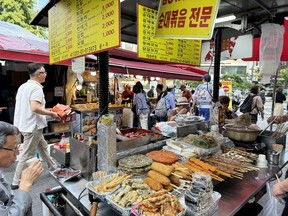
Reviews and recommendations are unbiased and products are independently selected. Postmedia may earn an affiliate commission from purchases made through links on this page.
Inside a tiny restaurant in Seoul’s bustling Gwangjang Market, a worker prepares Korean dumplings, called mandu, by hand. He spreads a filling of minced pork and kimchi onto a circle of pastry, then expertly folds the dumpling into a half-moon shape with a scalloped seal.
Moments later, the beautifully contained snacks arrive at our table, along with a tangy soy dipping sauce and the country’s ubiquitous metal chopsticks. I dispatch each dumpling in two bites, savouring the doughy, spicy and incredibly satisfying mini-meal.

So far we’ve also sampled raw octopus dipped in gochujang (fermented red chili paste), fish cakes served in broth, and tteokbokki, which is the nation’s sweet and spicy gnocchi approximation. Up next: salty, flaky bread rolls and green plum iced tea in Ikseon-dong Hanok Village, a trendy dining and shopping enclave.
“We always do a food tour first thing when we arrive in a new city,” says Jody Luth, visiting from Portland, Ore. “It not only shows you what to eat but the nicest parts of the city.”
It’s a delicious introduction to Seoul, a city of 10 million whose foods are as new to me as the charming wood frame and clay-tiled roof hanok architecture found in some of the centuries-old, restored neighbourhoods.

Since nothing beats jet lag like food, fresh air and sunshine, after the tour — and over the next several days — my husband and I explore on foot. Ikseon-dong borders the city’s central “palace district,” where five palace complexes are located within walking distance of one another. Seoul’s oldest and most picturesque hanok village, Bukchon, is nestled between the two most famous palace grounds.

We begin at Changdeokgung Palace, a UNESCO World Heritage Site with a 600-year history that’s recognized for how its buildings were positioned to integrate with their environment. I’m in awe of the elaborately painted wood offices and residences, with their sloping tiled roofs and the ornamental animal shapes, including a mythical unicorn lion, perched on high to guard over them.
The site’s true idyll is its secret garden, a tranquil forest interspersed with lily pad-festooned ponds and ornate pavilions.
“This was the most loved place by kings,” says our tour guide, explaining that 13 kings lived here over a span of 300 years.
The serenity is soon forgotten at neighbouring Gyeongbokgung Palace, which served as the official royal palace for centuries. Here, groups of residents and tourists compete for preferred photo spots in the main square, many of them dressed in “hanbok,” which is traditional Korean clothing. So widespread is this phenomenon, that there are hanbok rental shops just outside the palace gates.

Though it’s perfectly okay for foreign tourists to wear hanbok, the hot day drives us toward nearby Kiwa Taproom, where we spend our money on cold craft beer instead. The hopping pub is located on the outskirts of Bukchon inside a hanok building that overflows with history and charm. Like the fantastic Art Monster in Ikseon-dong, it’s one of Seoul’s many craft breweries that balance the city’s ancient attractions with modern tastes.
Fortified, we stroll through Bukchon’s maze of narrow alleyways at sunset. From the winding, hilly streets, it’s easy to enjoy the contrast of sloped hanok rooflines framing skyscrapers in the distance, along with the ever-present mountains that lie to the north, south, east and west of the city centre.

The city’s location — built around Gyeongbokgung Palace at its centre — is by design. King Taejo, the founder of the Joseon Dynasty back in 1392, aimed to capture the energy of the mountains (and thus good fortune) by placing buildings in auspicious positions, a practice called pungsu–jiri, or geomancy.
Centuries later, the result is a city with multiple hiking options on its periphery, including spectacular Bukhansan National Park, whose granite-studded mountain is Seoul’s highest peak. There are even parks and trails in the heart of Seoul, so on our final day, we hike up Namsan Mountain, drawn skyward by N Seoul Tower, a local landmark, to the summit.

From the top, a sea of office and residential towers peek from behind the forest’s foliage, and we enjoy a quiet moment removed from the city’s bustle. Afterwards, legs wobbly from the exertion, it’s mere steps to Namdaemun Market, an outdoor bazaar that rivals Gwangjang.
We wander through the warren of streets where vendors hawk gimbap, dumplings and spicy chicken skewers, and shops sell tubs of gochujang, fresh produce, dried mushrooms and spices like ginger root. In just a few days we’ve come to embrace these culinary choices and soon spy a packed restaurant.
“It’s delicious!” another tourist gushes as we squeeze into two remaining seats. Soon, small dishes of pickled radishes and house-made kimchi, and two heaping bowls of bibimbap (a Korean rice bowl topped with a medley of veggies and an egg sunny side up) are set upon the table. I grab the metal chopsticks, dig in, and savour my last bites of Seoul.